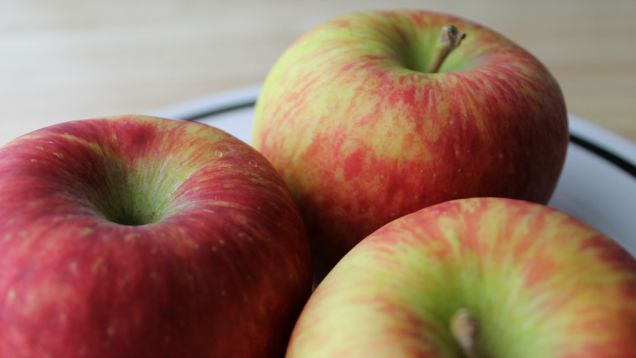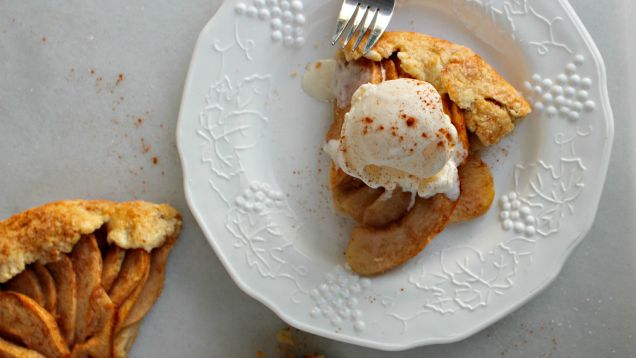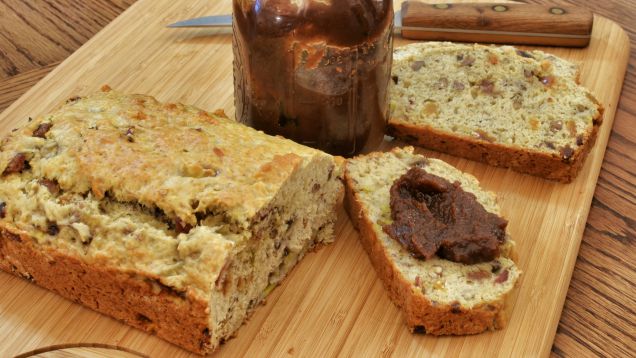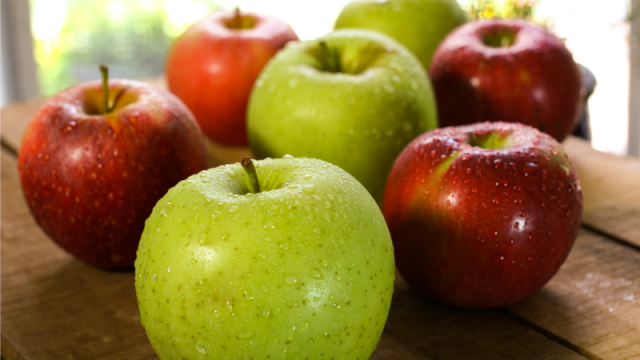At first blush, apples might seem pretty boring (that’s the fruit that got mankind expelled from paradise?) but a perfectly crisp, sweet and tart apple, fresh from the tree, is a beautiful thing — but each variety has its strengths and uses.
Photos by Jackson’s Orchard, Kirinohana, Claire Lower, JeffreyW, and Japen Go.
There are a ton of apples out there, and you shouldn’t be afraid to get out there and explore each and every one. If all you’ve had is Red Delicious (more like “Red Dumbface” am I right?), you are missing out, my friend. Next time you find yourself at the market, count the types of apples. If you’re at a grocery store, there will probably be four or five, but the farmer’s market? You will find tens of apples, literally tens. (As in like, 10-20.) The traits that make one type of apple great for eating out of hand (delicate, fresh flavour and lots of juice) can make it less than ideal in a pie (aka “mush city”).
But, as is the case with many culinary questions, there is sometimes more than one “right” answer, and personal preference can trump empirical data. (For instance, my mother roasts her Brussels sprouts until they are mush. Is this wrong? Yes, it is a crime against Brussels sprouts, but yelling Alton Brown quotes at her isn’t going to change her preference.) So, instead of lecturing you on what apples you “should” be eating, baking, and drinking, I’m going to arm you with the knowledge that let’s you make better apple choices, because “the more you know” applies even to apples.
So Fresh, So Crisp: Galas, Honeycrisps, and Fujis for Snacking

Apples are, quite possibly, the easiest snack in the world. You don’t have to peel them; simply rinse and get to chomping. Not all varieties are well-suited for fresh eating, though. The perfect apple should be a balance of fresh sweetness and bright acidity, with crisp, juicy flesh and that distinct “appley” aroma brought to us by esters. Basically, the opposite of the mealy, one-note, stupid stupid Red Delicious.
According to food writer Harold McGee, the best “dessert” or “eating” apples have a pH of 3.4 and are around 15% sugar. This isn’t the most useful information (unless you have some sort of food laboratory hidden behind your bookshelf), but it is interesting. So which ones should you buy for putting directly into your beautiful mouth? According to this adorably homely you-pick website that I’ve been obsessed with for years, the best fresh apples are Gala, Honeycrisp, Cameo, Pink Ladies and Fuji. These are the apples you want on your cheeseboards, my friend. They don’t show Granny Smith (which can have a pH of 3.3-3.9) much love, but if you’re like me and love yourself a tart apple, you really can’t go wrong with the Granny. (Bonus: sprinkle a little salt on there. I don’t know why but my grandmother salts pretty much all of her fruit and it really takes it to a delicious place. My grandmother is a genius.)
Get Baked: Golden Delicious for Desserts

When cooking apples, you’re looking for two things: something that won’t break down into a mushy mess, and something that will maintain its flavour. I’m not sure that there’s one single perfect baking apple, but most certified apple experts™ would agree that the Golden Delicious comes close.
In a very extensive (and very delicious) pie study conducted over at Serious Eats, the great J. Kenji Lopez-Alt found that apples of this variety had a great sweet and tart, buttery flavour, but that they were slightly lacking in the texture department. Still, he gave the Golden an 8 out of 10, which is a very respectable rating coming from a man of such exacting taste and opinions. (Guess what the stupid Red Delicious got? A “1”! Suck it, Red D.)
You might think the solution is as simple as mixing in a firmer, less flavorful apple, but when it comes to pies, Kenji is a one-apple man, describing pies with two apple varieties as “a pie that’s got nice firm chunks of apple interspersed with brown apple mush.” Instead, he firms the Goldens up by par-cooking them to convert the pectin (the fruit “glue” that helps the apple keep its shape) into a more heat-stable form, preventing liquid from leaking out and turning your pie into a soupy mess:
The easiest way to do this? Pour boiling water over your sliced apples and let them rest for about 10 minutes before drying them, tossing them with cinnamon, sugar, and cornstarch (to help thicken their juices), and piling them into the pie shell and baking them.
(You can also strengthen pectin’s bonds by adding lemon juice — pectin does better in acidic environments — but you’ll end up with a lemony pie, which might be ok with you.)
Of course, there are other schools of thought on mixing apples. America’s Test Kitchen is a fan of apple mush, and their recipe relies on the McIntosh’s textural tendencies to provide “a nice, juicy base for the harder Grannies.” Don’t know who to trust? Make both and see which you like better. It should be noted, however, that ATK’s recipe was engineered to be made with apples you can get at any grocery store at any time of the year, while Kenji’s is meant to be made during Golden Delicious season, preferably with apples you’ve picked yourself just hours before, so maybe save the ATK pie until the end of apple season.
Of course, no one is saying you can’t experiment with your own apple combinations. Want to see how an apple will hold up without baking an entire pie? Test them out à la McGee (he gives us so much) and wrap a few slices in foil and bake for fifteen minutes, or microwave them wrapped in plastic wrap until the plastic balloons fill with steam.
Smooth as Butter: Boil Down Braeburns (and Others)

Apple butter is basically applesauce on steroids. You make applesauce, but then you keep going until the sugars caramelize and it gets all nice and spreadable. Then spread it on bread, spoon it into yogurt, or dollop it on pork chops. You could start with store bought applesauce, but homemade is most likely going to taste better, especially if you start with the best-tasting apples.
Recommendations for which apples make the best butter are kind of all over the place. Some advocate the use of only the softest apples such as Braeburns, McIntosh, Fujis, and Courtlands. While it is true that softer apples will cook down faster, the same, firmer apples that are so good in pies (such as Yellow Delicious) can be apple butter if you cook it long enough (and believe in yourself). The only apples that aren’t really recommended are the harder varieties like Rome, and the too-mealy Red Delicious. (For a super easy apple butter that will make your home smell divine, use this Crockpot recipe.
Liquid Assets: Honeycrisps, Galas, and Cameos for Juice and Cider

There are two ways to drink your apple-a-day. You can juice the bastards and enjoy the resulting liquid in all of their fresh, unpasteurized glory, or ferment them. Guess which one I prefer?
For plain, healthful juice, I would recommend sticking to the same apples you enjoy the raw flavour of. These would be again be your Gala, Honeycrisp, Cameo, and Fuji, with Honeycrisps giving you the most bang for your buck, liquid-wise. There’s also no reason you can’t make a blend here. Need to up the sweetness without adding in much else? This is the only time I will recommend a Red Delicious. Need more acid? Granny’s got your back. The only apples you should really avoid when juicing are the dryer varieties, like Rome and Arkansas Black. To juice your apples, throw them in a juicer (duh) or steam or simmer the juice out of them using these instructions.
Now that we’ve gotten the boring part out of the way, let’s talk apple booze. There are multiple ways to go about this, and it’s a topic you can really sink your teeth into, but at its simplest, you just need to throw some yeast into some juice and letting the little buggers convert sugar into alcohol. Since you want your juice to ferment, you need to provide the yeasties with a good bit of sugar. According to Serious Eats, this means that half of your juice should come from apples with a high sugar content and low acid (think Golden Delicious, Johngold, Macoun, Gala, Fuji, Braeburn, and Honeycrisp). Once you have at least 50% sweet juice, you can balance it out with sharp apples (like Granny Smith or Rhode Island Greenings if you can find them), just keep their contribution to around a quarter of the juice. The remaining juice can come from sweet apples, or semi-sweets, like McIntosh, Baldwins, Cortlands.
The easiest, laziest, most elegantly schlocky way to accomplish this is to use my method of throwing a gram of champagne yeast into 2 litres of juice. (This actually works with any juice that has at least 20 grams of sugar per serving and is free of preservatives.) Just pour the yeast in a (clean) bottle with the juice, pop on an airlock, and let it go for a couple of days. The article linked above can walk you through details like how to calculate A.B.V., but it’s really quite simple. If you want to greatly decrease the chance of off-flavours, add a crushed Campden Tablet (or a portion of a tablet, depending on your volume) to the juice before adding the yeast. This will kill any wild yeast you might have floating around in there (which can mess up your flavour profile), but won’t “sterilize” your fresh apple juice.
If you wish to enjoy a more, ahem, refined product, HowToMakeHardCider.com is your new best friend. On it, Jessica Shabatura will gently guide you through the whole process, from sterilization, to choosing the right yeast, to carbonation and bottling. Her method is slightly more complicated than mine (and requires a few more ingredients and supplies), but the outcome is more certain.
So, how do you like them apples? (Sorry, but I’ve been waiting over a thousand words to say that.) Whether in pies, eaten fresh, or fermented into hard cider, apples are the fruit that keeps on giving. I still don’t think they were worth getting kicked out of Eden for, but they definitely aren’t boring…as long as you stay away from that @%$USing Red Delicious.

Comments
5 responses to “Forget Red Delicious: Here Are The Apples You Should Use In Everything”
Red delicious are probably the worst apples I have ever tasted.
Absolutely. It sounds stupid, but it’s almost like I can taste the redness and it’s foul.
For me, it’s Pink Lady or nothing.
Yes, and Fuji’s. Red delicious have this horrible pasty texture to them. Ugh.
I was skeptical of Fuji apples at first, because their skin is so dull and dry looking. That outside is so deceptive though! Definitely my favourite apple.